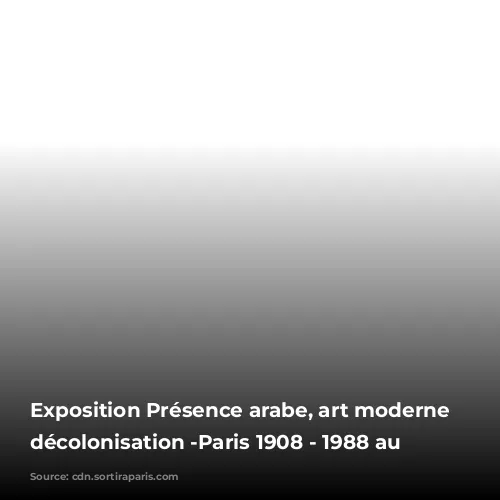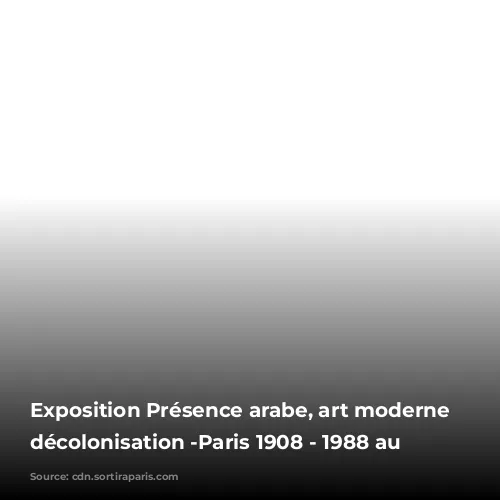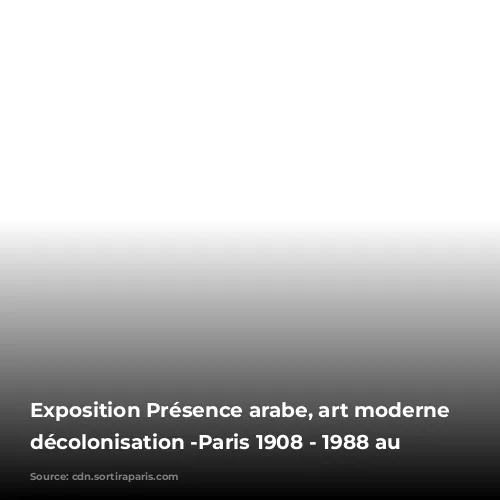Get ready to discover a hidden world of artistic brilliance! The Musée d’Art Moderne de Paris (MAM) presents a captivating exhibition, “Présences arabes. Art moderne et décolonisation, Paris 1908-1988,” showcasing over 200 exceptional works by Arab artists – many never before seen in France. This collection offers a unique glimpse into the evolution of Arab art, from its beginnings under colonial influence to its powerful expression of cultural identity and liberation.
Beyond the Familiar Names
We often associate the 20th century with celebrated artists like Warhol, Picasso, and Dali. While their works are widely recognized, there are countless other artists who have enriched the art world with their talent and vision. This exhibition sheds light on the contributions of Arab artists, many of whom remain relatively unknown in Europe.
Unveiling a Rich Artistic Heritage
The MAM is dedicated to showcasing the artistry of 20th-century Arab artists from countries like Syria, Morocco, Egypt, Iraq, Algeria, and Tunisia. This exhibition, running from April 5 to August 25, 2024, is a significant step towards recognizing their impactful contributions to modern art.
More than 200 works – paintings, sculptures, photographs, and audiovisual archives – paint a vibrant tapestry of Arab artistic expression. Through this collection, we discover the intricate connections between Arab artists and Paris, a city that served as a cultural hub from the early 1900s to the dawn of the 21st century.
The exhibition highlights nearly 130 artists, many of whom have been unjustly overlooked. Their works, however, have played a crucial role in shaping the Arab avant-garde and the broader landscape of modern art.

The Journey of Identity and Liberation
The 20th century was a pivotal era in the formation of Arab identity. As Arab nations embarked on a path of decolonization, art emerged as a potent tool for self-expression and the construction of a distinctive national and cultural identity. Schools, salons, museums, and cultural exchanges provided a platform for Arab artists to find their voice and receive recognition for their artistic contributions.
From Colonial Influence to Artistic Freedom
The exhibition unfolds in four parts, each exploring a significant period in the evolution of Arab art:
1. The Nahda: A Cultural Awakening
The Nahda, the Arab cultural renaissance, emerged as a response to both Western influence and colonial dominance. This period, symbolized by the work of Egyptian sculptor Mahmoud Mokhtar in Paris, embodies a yearning for freedom and openness while simultaneously seeking to reclaim and celebrate Arab cultural identity.
Early Arab artists, inspired by the French Beaux-Arts model, often depicted their own culture through an orientalist lens, perpetuating stereotypes and limiting their creative expression.
However, artists like Philippe Mourani, Mohammed Racim, and Mahmoud Saïd broke free from these constraints, expressing a genuine and authentic vision of the Orient. This era also witnessed the rise of an intellectual and anti-colonial movement, fueled by critical journals, satirical art, and private galleries, which challenged colonial narratives and asserted Arab cultural autonomy.
2. Independence: Embracing the Avant-Garde
With independence came a renewed sense of artistic freedom and a desire to reconnect with heritage. The period between 1937 and 1956 saw artists in newly independent countries like Lebanon, Syria, Egypt, and Iraq embrace the avant-garde, rejecting orientalism and embracing a more contemporary artistic language.
Groups like Art et Liberté in Egypt and the Algerian artist Baya embodied this artistic rebellion, weaving together surrealism, anti-colonial sentiment, and a profound search for artistic authenticity. Paris, a cosmopolitan crossroads, provided young Arab artists with access to the currents of abstraction and avant-garde art, contributing to the evolution of Arab artistic expression in the post-colonial context.
3. Decolonization: Art as a Weapon of Resistance
The period of decolonization was fraught with violence and political turmoil, influencing the art scene profoundly. From 1956 to 1967, modern art in North African countries became a platform for challenging colonial oppression and promoting cultural diplomacy.
The Algerian revolution sparked solidarity among French artists, who used their art to express support for the Algerian people. Movements like the Casablanca School and the Aouchem group used art to expose the injustices of colonial rule.
Despite the integration of Arab artists into the French cultural landscape, the contradictions and dilemmas of artistic identity in exile reflected the complexities of decolonization and the impact of political events, such as the repression of October 17, 1961, on the art world.
4. Committed Art: Voices of Resistance and Change
From 1967 to 1988, Arab art and intellectualism, deeply affected by the Six-Day War and Israel’s victory, resonated with a global context of struggles for emancipation. Strong solidarity for the Palestinian cause in France echoed the movements of May ’68, creating a powerful synergy of artistic and political activism.
Arab artists used art as a weapon of resistance and political expression, participating in the Salon de la jeune peinture in Paris and collaborating with various collectives. They challenged censorship in their home countries, demonstrating the vitality and resilience of Arab counter-culture.
Etel Adnan’s “Arab Apocalypse,” a powerful cry against regional violence, foreshadowed the horrors of massacres like those at Sabra and Chatila. Simultaneously, a postcolonial consciousness emerged in France, criticizing the inequalities and violence faced by immigrant communities. Museum initiatives aimed to celebrate these diverse cultures within French society.

A Must-See Exhibition: Unveiling Forgotten Stories
This exhibition is a captivating journey through history and art, revealing the brilliance of Arab artists, many of whom have been unjustly forgotten. It offers a compelling opportunity to explore a crucial chapter in recent history.
Make sure to visit the Musée d’Art Moderne de Paris and experience the powerful stories and remarkable talent showcased in “Présences arabes. Art moderne et décolonisation, Paris 1908-1988.” It’s an exhibition that will stay with you long after you leave, leaving you with a deeper understanding of Arab art and its profound impact on the global art scene.

































